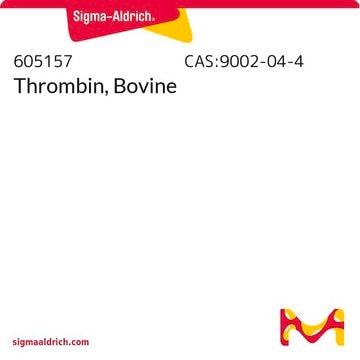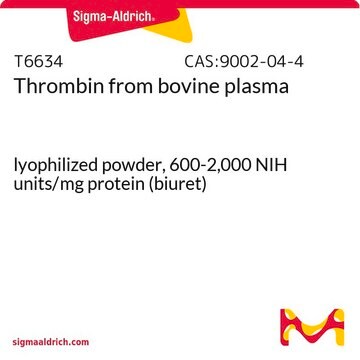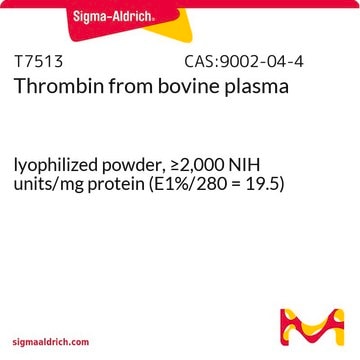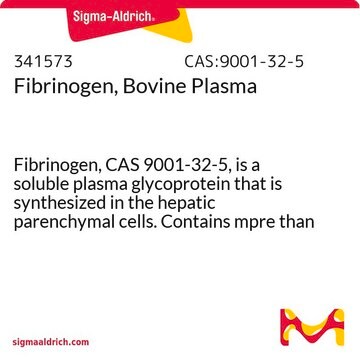T7326
Trombina from bovine plasma
≥60 NIH units/mg protein (biuret)
Sinónimos:
Factor IIa
Iniciar sesiónpara Ver la Fijación de precios por contrato y de la organización
About This Item
Número de CAS:
MDL number:
UNSPSC Code:
12352204
NACRES:
NA.54
Productos recomendados
form
lyophilized powder
specific activity
≥60 NIH units/mg protein (biuret)
composition
Protein, ≥50%
storage temp.
−20°C
¿Está buscando productos similares? Visita Guía de comparación de productos
General description
Thrombin is the final coagulation protease in regard to hemostasis, promoting both procoagulant and anticoagulant effects. Thrombin comprises of A-chain and B-chain with the catalytic pocket. The C-terminal regions has a fibrinogen recognition site (FRS) and a heparin binding site (HBS). The main function of thrombin is cleavage of fibrinogen to fibrin. It coordinates the coagulation cascade and coordinates with protease-activated receptors (PARs) to regulate physiological functions. High levels of thrombin causes neurotoxicity in dopaminergic neurons and contribute to the progression of parkinsons disease. Altered thrombin levels modulates coagulation pathway in multiple sclerosis. Patients with coronary artery disease (CAD) show elevated levels of thrombin.
Application
Thrombin from bovine plasma may be used:
as revitalization model to mimic blood fabrication in root canal
- for the generation of fibrin from fibrinogen embedded in microbubbles
- for the cleavage of hydrogenase maturation protein (HypF-N) from the nickel resin
as revitalization model to mimic blood fabrication in root canal
Thrombin is used for site specific cleavage of recombinant fusion proteins containing an accessible thrombin recognition site for removal of affinity tags. Thrombin has been used in a study to evaluate coagulation abnormalities in acute liver failure.
Biochem/physiol Actions
Serín proteasa que hidroliza selectivamente los enlaces Arg-Gly en el fibrinógeno para formar fibrina y fibrinopéptidos A y B.
Unit Definition
Activity is expressed in NIH units obtained by direct comparison to a NIH thrombin reference standard.
Physical form
Lyophilized powder containing sodium chloride and Tris-HCl, pH 7.0
Preparation Note
Traditional thrombin products are activated with bovine brain thromboplastin, whereas T7326 is activated with bovine lung thromboplastin and does not contain any bovine brain products in its preparation.
Analysis Note
En el procedimiento de análisis NIH se utilizan 0,2 ml de plasma diluido (1:1 con disolución salina) como sustrato y 0,1 ml de muestra de trombina (estabilizada en una disolución de albúmina tamponada al 1 %), basado en una modificación del método de Biggs. Para determinar las concentraciones de trombina sólo se utilizan los tiempos de coagulación comprendidos entre 15 y 25 segundos.
La actividad se expresa en unidades NIH obtenidas por comparación directa con el patrón de referencia de la trombina NIH, lote K.
Other Notes
View more information on thrombin at www.sigma-aldrich.com/enzymeexplorer.
Storage Class
11 - Combustible Solids
wgk_germany
WGK 3
flash_point_f
Not applicable
flash_point_c
Not applicable
ppe
Eyeshields, Gloves, type N95 (US)
Certificados de análisis (COA)
Busque Certificados de análisis (COA) introduciendo el número de lote del producto. Los números de lote se encuentran en la etiqueta del producto después de las palabras «Lot» o «Batch»
¿Ya tiene este producto?
Encuentre la documentación para los productos que ha comprado recientemente en la Biblioteca de documentos.
Los clientes también vieron
Banwari Agarwal et al.
Journal of hepatology, 57(4), 780-786 (2012-06-28)
In acute liver failure (ALF), prothrombin time (PT) and its derivative prothrombin time ratio (PTR) are elevated, and are considered predictors of increased bleeding risk. We aimed at determining whether increased PT/PTR reflects the haemostatic potential and bleeding risk in
Backbone NMR assignments of HypF-N under conditions generating toxic and non-toxic oligomers
Patel JR, et al.
Biomolecular NMR Assignments, 1-5 (2018)
Increased plasma thrombin potential is associated with stable coronary artery disease: An angiographically-controlled study
Tosi F, et al.
Thrombosis Research, 155, 16-22 (2017)
Fibrin-Targeted Polymerized Shell Microbubbles as Potential Theranostic Agents for Surgical Adhesions
Gormley CA, et al.
Langmuir (2019)
A training model for revitalization procedures
Widbiller M, et al.
International Endodontic Journal, 51, e301-e308 (2018)
Nuestro equipo de científicos tiene experiencia en todas las áreas de investigación: Ciencias de la vida, Ciencia de los materiales, Síntesis química, Cromatografía, Analítica y muchas otras.
Póngase en contacto con el Servicio técnico










